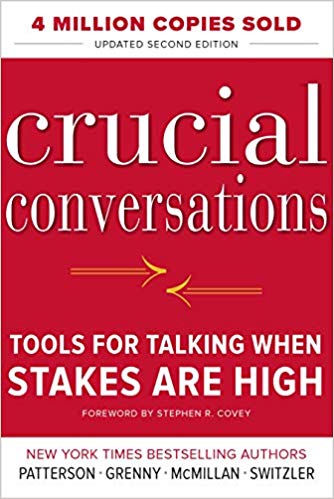

This article is an excerpt from the Shortform summary of "Crucial Conversations" by Kerry Patterson. Shortform has the world's best summaries of books you should be reading.
Like this article? Sign up for a free trial here .
What are some verbal communication strategies you should be aware of? Which ones should you use? Which ones should you avoid?
We use various verbal communication strategies when we engage in conversations at home and work. There are three strategies—silence, violence, and “clever stories”—that you should seek to avoid, but it’s important to recognize when they are in use. Two strategies—useful stories and contrasting—lead to constructive dialogue and should be part of your skill set.
Continue reading to learn about these verbal communication strategies.
Verbal Communication Strategies
While some of these strategies are not advisable, it is important to recognize when you or others resort to them. Silence, violence, and “clever stories” fall into this category. The last two verbal communication strategies—useful stories and contrasting—are valuable skills you can develop.
Silence
Silence is any act to purposely withhold information from the pool of meaning. People usually go silent to avoid problems.
Behaviors include playing verbal games or avoiding a person entirely. But the most common forms of silence are masking, avoiding, and withdrawing.
- Masking: Understating or selectively showing your true opinions using sarcasm, sugarcoating, and couching. For example: “Oh, sure. That’ll work like a charm.”
- Avoiding: Steering completely away from sensitive subjects; you talk without addressing the real issues. For example, when someone asks how you like their outfit, you respond: “Well, you know red’s my favorite color.”
- Withdrawing: Pulling out of a conversation; withdrawing or even leaving the room. For example, “I just can’t talk about this right now.”
Violence
Violence is a verbal communication strategy to convince or compel others to accept your point of view. Trying to force meaning into the pool violates safety. Behaviors include name-calling, filibustering, and making threats, but the most common are controlling, labeling, and attacking.
- Controlling: Coercing others to your way of thinking by either forcing your views on others, or dominating the conversation. Methods include cutting others off, overstating your facts (hyperbole), speaking in absolutes, changing subjects, or using directive questions to control the conversation. For example: “Everyone knows they have the worst customer service in the universe.”
- Labeling: Attaching a label in order to stereotype or dismiss someone or their idea. For example, “You sound like a Neanderthal.”
- Attacking: You move from winning the argument to making the other person suffer. Tactics include belittling and threatening. For example: “You’re a real jerk! I’m sorry but someone has to tell the truth here.”
‘Clever Stories’
Our stories fall into one of two categories:
- Accurate stories that motivate constructive behavior.
- Inaccurate stories that justify our current behavior so there’s no need to change.
The second category comprises clever stories, which allow us to feel good about behaving badly.
They often start with a sellout — an instance in which we’ve consciously acted against what we know is right. For example our sellout may be that we refused to let someone merge into traffic when we should have. After the fact, we tell a story characterizing the other person as a bad driver to justify our rude behavior.
Other common sellouts:
- You should help someone but you don’t.
- You should apologize but don’t.
- You should listen but become defensive instead.
- You recognize problems but don’t speak up.
You can either own up to your sellout or try to justify it. Instead of admitting errors, we often tell clever stories to justify them.
Clever stories take three basic forms:
1. Victim stories — It’s not my fault: With victim stories you portray yourself as innocent. Someone else did something and you’re suffering as a result.
Sometimes, you may an innocent victim, but more often you intentionally ignore the role you played in the problem. You tell your story in a way that avoids addressing what you did that might have contributed to the problem.
For example, you complain that your boss disrespected you or treated you unfairly when she took you off a big project. But you neglect to acknowledge that you contributed to the situation by not letting her know you were behind on the work, leaving her in the lurch.
2. Villain stories — It’s someone else’s fault: You may also create stories that portray others as villains. You exaggerate your own innocence by overemphasizing the other person’s guilt or stupidity.
For example, You might describe a boss who is gung ho about quality as a control freak who likes to make employees miserable, rather than acknowledge making mistakes yourself. Labeling (e.g. control freak) is common in villain stories. It’s a way of dehumanizing people, so you feel OK about attacking them.
Victim and villain stories reflect a double standard — when you make a mistake, you’re a victim; when others make mistakes they’re villains for inconveniencing or hurting you.
3. Helpless stories: You portray yourself as powerless to do anything constructive. You convince yourself you have no good alternatives, which justifies your actions.
For example, you might say: “If I didn’t yell, he wouldn’t listen,” or “If I confronted the boss, she’d get angry at me.”
Victim and villain stories explain why we’re in the situation we’re in. Helpless stories explain why we can’t do anything to change our situation.
Helpless stories often grow from villain stories and offer fool’s choices — we can be honest and ruin the relationship or stay silent and suffer. We attribute unchangeable traits to others. For example, we claim that because colleague is a control freak (villain story), we can’t give her feedback; control freaks can’t handle it. We can’t change that (helpless story).
Why We Resort to Clever Stories
- Sometimes they’re true — we really are an innocent victim or maybe we really can’t do much to change the situation.
- Clever stories excuse us from any responsibility, when we are partially responsible.
- We can’t admit we’re wrong: Instead we emphasize others’ faults and our innocence and powerlessness.
- We did something we feel a need to justify. We sold out in some way, by acting against our own good judgment or conscience.
Useful Stories
Once you learn to recognize the clever stories you tell yourself, you can learn an important verbal communication strategy: Changing clever stories into useful stories. Telling a useful story instead creates emotions that lead to constructive actions, such as dialogue.
The key to transforming a clever or self-justifying story into a useful one is telling the full story. Clever stories leave out important information about ourselves, others, and about our options. They become useful stories when we add the missing information.
When you fill in the missing details, victims become actors, villains are humans, and helplessness is replaced with action.
1. Victims become actors: When you start describing yourself as a victim, ask: What’s my role in the problem?
Maybe you did something to help cause the problem, not necessarily from malicious motives, but perhaps from thoughtlessness. Considering your own role helps you see how you’ve minimized your mistakes and exaggerated the role of others.
For example, you may be upset because a coworker always seems to leave the difficult or less desirable tasks for you. But the missing detail is that you’ve never spoken up about it or made any attempt to learn why she does this.
2. Villains become humans: When you find yourself blaming others, stop and ask: Why would a reasonable person do this? There are a variety of possible reasons for everything. Asking this question helps us to humanize others, and to assume personal accountability.
The point is not to excuse others’ bad behavior but to address our own stories and emotions.
Considering alternate motives allows us to open our minds and engage in dialogue — so we can learn their true motives.
For example, the coworker who seemed to avoid tough jobs jumped in recently to help you with an important assignment. Your initial reaction was to be suspicious of her motives (maybe she was trying to make you look bad), but on second thought, maybe she really was trying to help you.
3. Helpless gives way to action: When you find yourself wallowing in helplessness you can tell the full story by returning to your original motive. Ask yourself what you really want. Reject the fool’s choice that’s made you feel helpless, by asking what you should be doing to get what you want.
By refusing helplessness and blaming others you force yourself to use your dialogue skills to address a problem rather than complaining about it.
For example, instead of feeling helpless to do anything about your coworker’s unhelpful behavior, you could prioritize your desire to have good work relationships and talk with her about how you could both contribute to this goal.
Contrasting
Sometimes when you’re sharing your views in crucial conversations, others believe unjustifiably that you’re out to harm or coerce them. You shouldn’t apologize because you haven’t done anything wrong. This would be disingenuous. To rebuild mutual purpose/mutual respect when others misinterpret your purpose or intent, you can use the verbal communication strategy of contrasting.
Contrasting is a two-part don’t/do statement that assures others that you respect them and clarifies your purpose. You explain what you don’t want, followed by what you do want.
Contrasting works this way (using the example of the manager explaining the VP visit to employees):
- “I don’t want to imply that I don’t value your work.” (What the manager doesn’t want)
- “I think your work has been outstanding and I want the leadership to understand the value of what you do.” (What he does want)
Of the two parts of contrasting, the don’t is more important because it deals with the misunderstanding that has undermined safety. You address the misunderstanding first, then explain what you intended.
In the Yvonne/Jotham conversation earlier, Yvonne could use contrasting when she returns to the conversation on intimacy: “I don’t want to put this all on you — it’s on both of us. What I do want is to be able to talk about it so we can improve things for both of us.”
Contrasting isn’t apologizing — it provides context and proportion. Sometimes when others take your words the wrong way, you’re tempted to water down what you’re trying to say. Don’t backpedal, but put your words in context: “Let me put this in perspective…I don’t mean to imply…”
You can use contrasting preemptively as well, to enhance safety when what you’re about to say could spark defensiveness: “I don’t want you to think I don’t appreciate…but…”
Practical tip: When people take something the wrong way and you start arguing over the misunderstanding, stop and use contrasting. Explain what you don’t mean until it’s safe to return to the conversation.

———End of Preview———
Like what you just read? Read the rest of the world's best summary of Kerry Patterson's "Crucial Conversations" at Shortform .
Here's what you'll find in our full Crucial Conversations summary :
- How to approach an argument without getting mad
- The mistakes most people make when trying to listen to someone else
- How to come up with win-win solutions that make everyone happy






